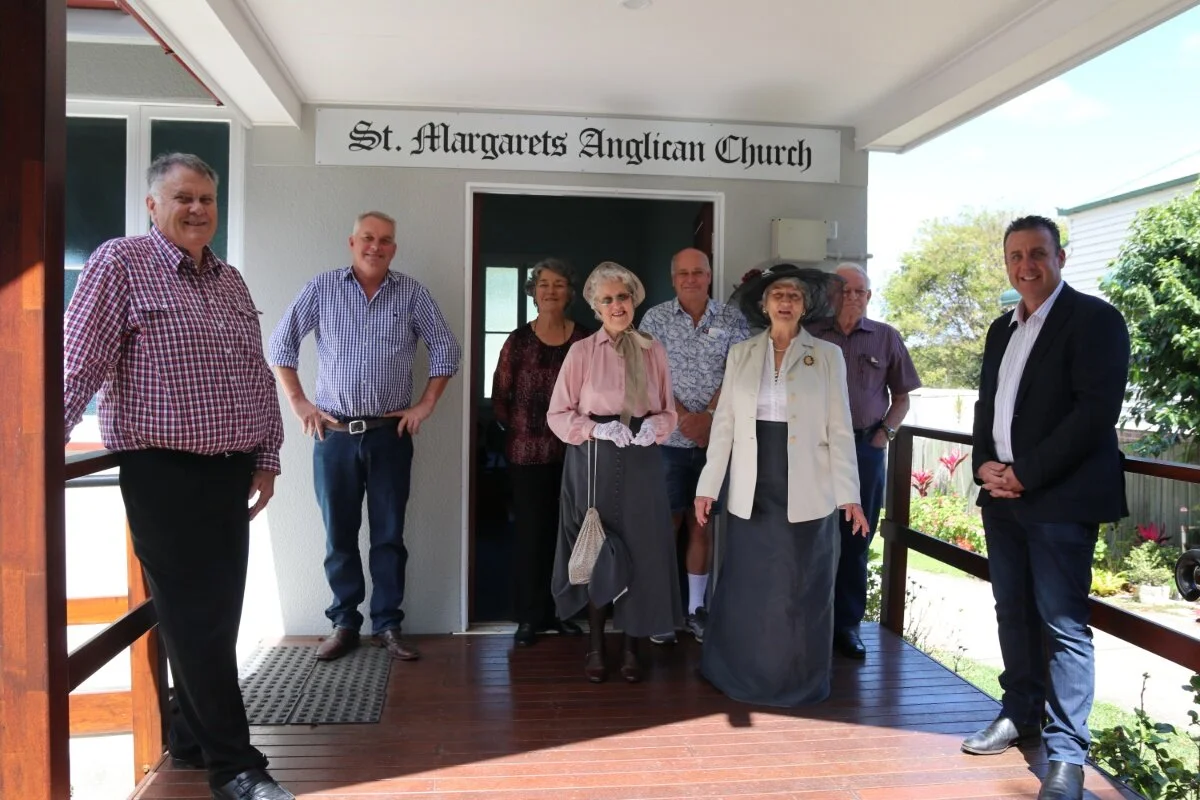Booklet provides fascinating insights into Woombye’s past
Cr Winston Johnston, Shadow Minister for Fire, Emergency Services and Volunteers Lachlan Millar, Lyn Mabb, Ian Smith and Ross Deller. In front Lyn Walker, Margaret Woodrow, and Member for Nicklin Marty Hunt.
A Heritage Trail booklet providing information on Woombye’s beginnings was launched at a series of rolling events on Saturday September 12.
“Our Place Our Story” includes a handy map directing visitors to sites of historical significance around town.
The Woombye Community & Business Association (WCBA) were able to hold a low key launch event at Woombye Pub under a Covid Safe plan.
Several of the “Our Place Our Story” heritage group met in period dress at St Margaret’s church and accompanied WCBA President Debbie Kimber, Cr Winston Johnston, Member for Nicklin, Marty Hunt and Shadow Minister for Fire, Emergency Services and Volunteers Lachlan Millar on a tour of some sites from the trail. This included a stop at the Woombye Community Library to donate copies of the booklet to Christine Molloy.
Cr Johnston launched the book at the Pub.
Margaret Woodrow, who compiled the book, said she thoroughly enjoyed the experience.
“It was interesting to compile and research – a lot of research. I needed new reading glasses by the time it was finished. But it is imperative to record history as fact otherwise it can get handed down and become a myth.
“People can walk or drive the trail and read about how and why each site is important in Woombye’s continuing narrative, at the actual place where the story began. We wanted something small to perhaps put in a back pocket or handbag while walking the trail.”
In attendance was Lucille Watson (aged 90) the great-granddaughter of Frederick Schubert who built the Criterion Hotel (Woomybe Pub) in 1900.
Cr Johnston said he was delighted to have provided funds for the printing of the historic record. He emphasised the importance of printed literature. Information has been available in numerous mediums, from slates for writing to CDs and digital media. “However the only medium that can be completely relied upon to provide easily accessed information for future generations, is the printed format.”
For that reason, he thanked and offered support and encouragement to all whom were involved in the production of this valuable record of history relating to Cobbs Camp, Woombye.
Woombye Business and Community association Vice President Grant Palethorpe said the booklet was a quality publication that would help inform and unite the towns residents and visitors.
“It is a credit to those involved,” he said. “Communities like Woombye have always worked together. The Woombye Community & Business Association engaged with The Light Horse, St Margaret’s Church, our local Scout troop and also the Community Library to make the day a success.”
Ms Kimber presented native bouquets from White Jasmine (Woombye Flowers & Gifts) to four of the ladies who helped with creation of the book including Judy Bandidt, Tess Martin, Lyn Walker and Mrs Woodrow.
WCBA plans to build on the momentum of the book with a formal heritage walking trail of the sites listed and an interactive storyboard in a prominent public space in Woombye.
The book was printed locally by 4CP Promotional Products & Graphic Design and will be available for $8 from Bendigo Bank and Woombye Rural Supplies.
Did you know?
The name Woombye was derived from the aboriginal word the black myrtle. It is one of the Eugenia family, as is the lilly-pilly. It grew profusely along the banks of Paynter’s creek, near the railway, and it was the Railway company that named each station as it went through – according to some characteristic of that area. It is a small tree or shrub, the white flower being quite distinctive. Early pioneers used its pliable wood for whip handles and riding crops. The aboriginal people used it for attaching to their stone axe as a handle (for a small axe).

